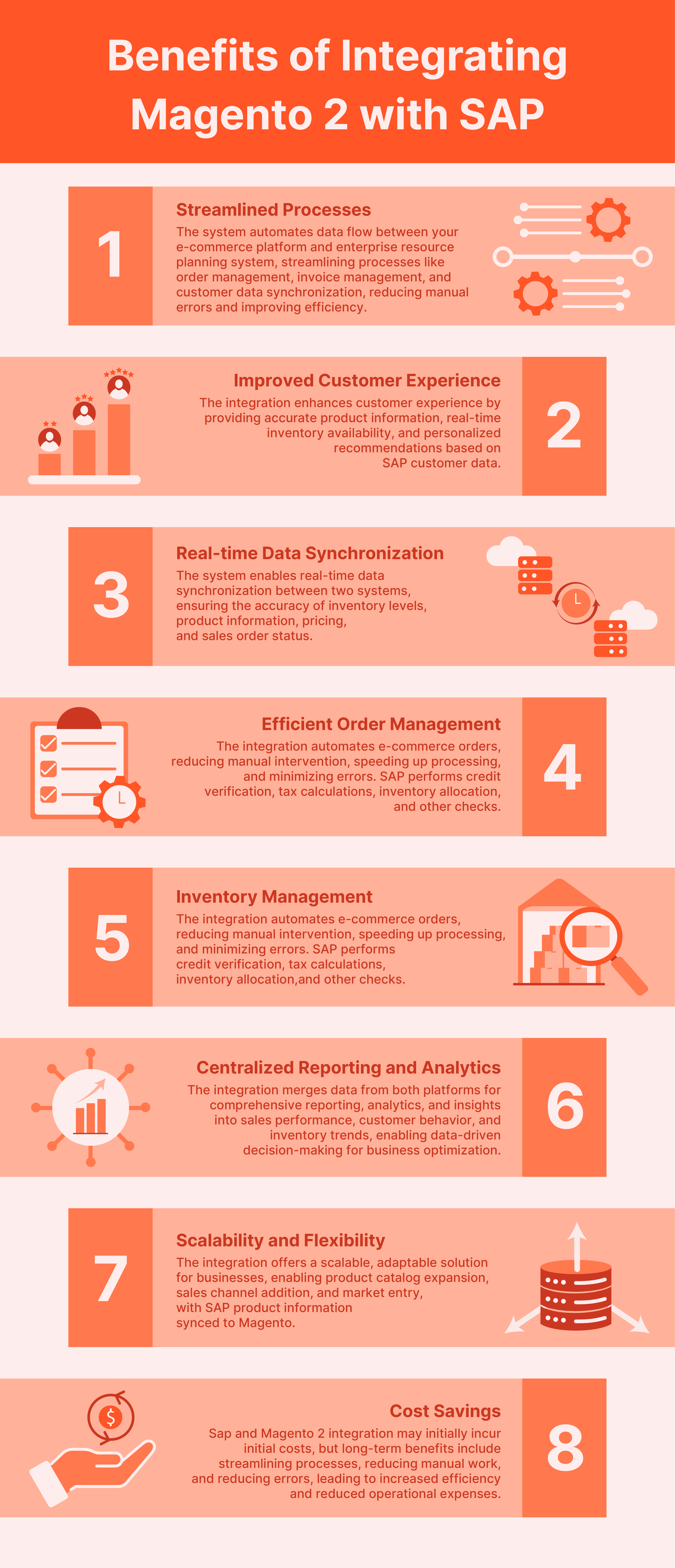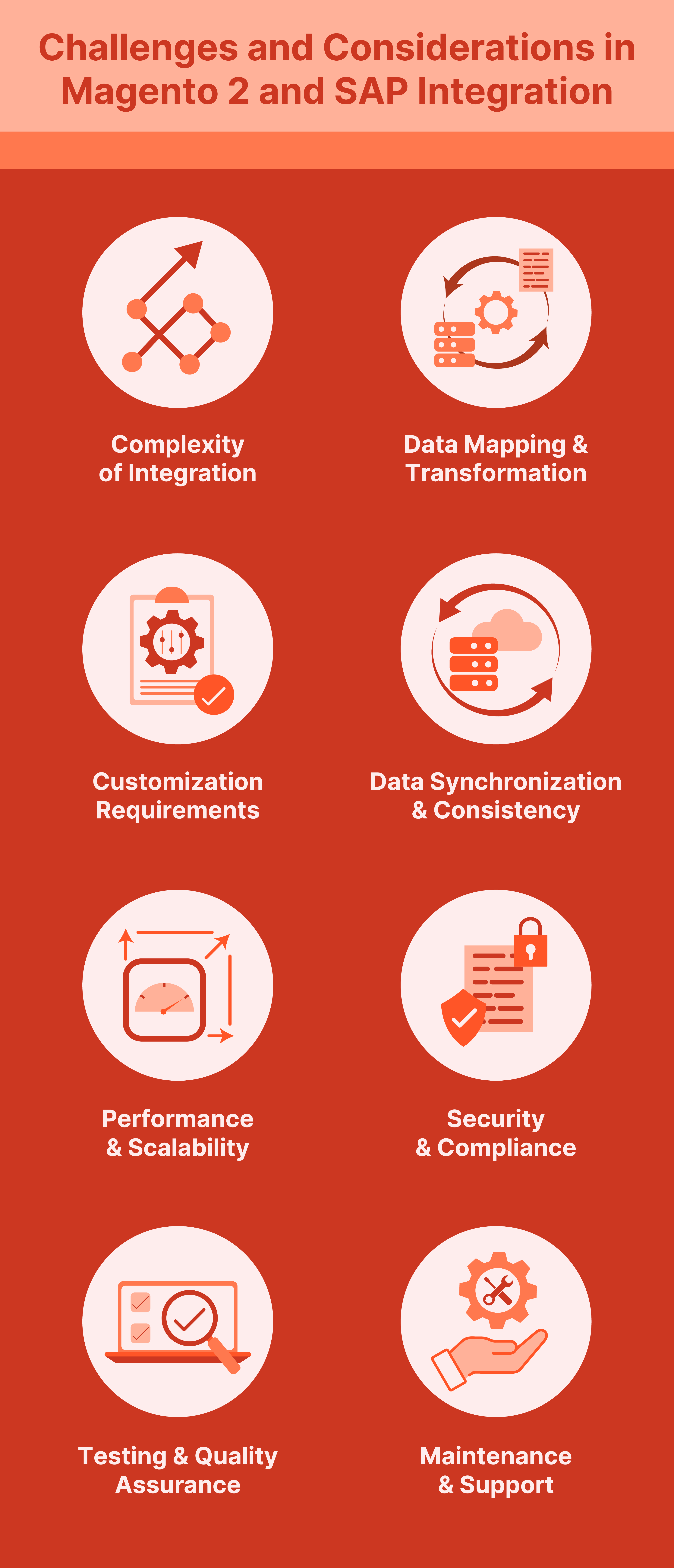
Magento 2 Sap Integration: Different Methods and Challenges
Want to integrate Magento 2 and SAP effectively? Magento 2 Sap Integration streamlines business processes and enhances customer experiences.
In this article, we will explore the benefits, challenges, and various integration methods.
Key Takeaways
-
Learn the benefits of Magento 2 Sap Integration, including streamlined processes.
-
Understand the challenges involved in Magento 2 Sap Integration, such as customization requirements.
-
Explore different integration methods and architectures, including custom API integration.
-
Discover how hybrid integration combines multiple approaches for optimal performance.
-
Challenges and Considerations in Magento 2 and SAP Integration
-
Different Integration Methods and Architectures for Magento 2 and SAP
Benefits of Integrating Magento 2 with SAP

1. Streamlined Processes
It automates uninterrupted data flow. It is between your e-commerce platform and your enterprise resource planning system. It streamlines various processes such as:
-
Invoice management
-
Customer data synchronization.
It reduces manual errors and improves efficiency.
2. Improved Customer Experience
The integration can provide a better customer experience by offering:
-
Accurate product information
-
Real-time inventory availability
-
Personalized recommendations based on customer data stored in SAP.
3. Real-time Data Synchronization
It allows for real-time synchronization of data between the two systems. It ensures that everything is always up-to-date, including:
-
Inventory levels
-
Product information
-
Pricing
-
Sales order status.
It leads to better decision-making and enhanced customer service.
4. Efficient Order Management
The integration transfers orders placed on your e-commerce website to SAP for processing. This automation helps by:
-
Reducing the need for manual intervention
-
Speeding up order processing times
-
Minimizing the risk of errors.
Since order details are automatically transferred, no manual re-entry is required. It saves time and prevents typos or missing information.
SAP automatically performs credit verification, tax calculations, inventory allocation, and other checks. Centralized order management in SAP also allows the efficient processing of high volumes.
5. Inventory Management
The integration enables accurate tracking of inventory levels across many channels. It helps prevent stockouts and reduce overstocking. It enables customers to see the real-time products in your Magento 2 store.
6. Centralized Reporting and Analytics
The integration can merge data from both platforms for comprehensive reporting and analytics. It provides valuable insights into:
-
Sales performance
-
Customer behavior
-
Inventory trends.
It also helps make data-driven decisions to optimize your business operations.
7. Scalability and Flexibility
The integration provides a scalable solution that can grow with your business. The integrated system can adapt to your changing needs, including:
-
Expansion of your product catalog
-
Addition of new sales channels
-
Entering new markets.
Product info is managed in SAP and synced to Magento. It enables the new products added to appear in Magento automatically. Multi-warehouse inventory from SAP can be exposed in Magento. It allows the e-commerce store to sell from all locations and channels.
8. Cost Savings
Initial costs are associated with Sap and Magento 2 integration. The long-term benefits often outweigh them. It helps:
-
Streamline processes
-
Reduce manual work
-
Cut errors.
The integration also leads to cost savings. It is in the form of increased efficiency and reduced operational expenses.
Challenges and Considerations in Magento 2 and SAP Integration

1. Complexity of Integration
The sync involves connecting two complex systems with different:
-
Architectures
-
APIs.
This complexity makes the integration process challenging. It may need expertise in both platforms or the help of experienced developers.
2. Data Mapping and Transformation
Mapping data fields between Magento 2 and SAP can be complex. It is due to differences in data structures and terminology. Businesses need to map and transform data. It helps ensure compatibility and consistency between the two systems.
3. Customization Requirements
Every business has unique requirements and workflows. Out-of-the-box integration solutions may not support everything. Customization may be necessary to tailor the integration to meet specific business needs.
It can help add complexity and cost to the project.
4. Data Synchronization and Consistency
Maintaining data consistency and synchronization between Magento 2 and SAP ensures accuracy in:
-
Order processing
-
Customer experience.
Businesses should use powerful synchronization mechanisms. It helps handle real-time data updates and cut data discrepancies.
5. Performance and Scalability
Integrating Magento 2 with SAP can impact the performance and scalability. This is especially true during peak traffic or high-volume transactions. Businesses need to assess the performance implications of integration.
They should also use optimizations to ensure scalability and responsiveness.
6. Security and Compliance
Integrating Magento 2 with SAP involves transferring sensitive business data between systems. It raises concerns about security and compliance. Businesses need to use powerful security measures, such as:
-
Data encryption
-
Access controls
These protect the data against unauthorized access. They also ensure compliance with data protection regulations.
7. Testing and Quality Assurance
Thorough testing helps identify and resolve any issues or discrepancies. They resolve all the issues that may arise during integration. Businesses should conduct comprehensive testing across different scenarios, including:
-
Data synchronization
-
Order processing
-
Error handling
It ensures the integrity and reliability of the integrated system.
8. Maintenance and Support
Integration is an ongoing process that requires regular maintenance and support to:
-
Address issues
-
Install updates
-
Accommodate changes in business requirements.
Businesses need to divide resources for ongoing maintenance. It also provides support to ensure the long-term success of the integration.
Different Integration Methods and Architectures for Magento 2 and SAP
1. Custom API Integration
The approach involves developing custom APIs (Application Programming Interfaces). It facilitates data exchange between Magento 2 and SAP. It offers flexibility to tailor the integration to specific business requirements.
It also supports real-time data synchronization and custom workflows. Development expertise is required to design and use custom APIs. It may involve higher development costs and longer implementation timelines.
2. Middleware Integration
Middleware platforms act as intermediaries between Magento 2 and SAP, including:
-
MuleSoft
-
Dell Boomi
-
SAP Process Integration (PI/PO).
It facilitates data exchange through pre-built connectors or adapters. It provides a standardized approach to integration with pre-built connectors and transformation capabilities.
It also supports complex integration scenarios and handles data mapping and transformation. Middleware platforms may incur extra licensing costs. Configuration and customization may be required to meet specific integration requirements.
3. Direct Database Integration
It involves directly accessing the databases of Magento 2 and SAP to exchange data. It offers a straightforward approach to integrating data. The integration doesn't rely on APIs or middleware.
It also supports batch processing and bulk data transfer. Direct database access may pose security risks. It requires careful consideration of data privacy and compliance. Changes to database schema or data structure may impact integration.
4. Message Queue Integration
It utilizes message queuing systems like RabbitMQ or Apache Kafka. These help asynchronously exchange messages between Magento 2 and SAP. It enables the decoupling of systems and improves scalability and fault tolerance.
These support asynchronous communication and can handle high-volume transactions. It requires setup and configuration of message queuing infrastructure. Complexity may increase with the need to manage message processing and error handling.
5. EAI/ESB Integration
EAI or ESB platforms include Apache Camel or MuleSoft Anypoint platform. They provide middleware capabilities. These ease the integration between Magento 2 and SAP.
It offers a centralized platform for managing integrations with built-in support for:
-
Routing
-
Transformation
-
Protocol mediation.
It facilitates integration with other enterprise systems. EAI/ESB platforms may need specialized expertise for configuration and maintenance. Licensing costs and scalability considerations should be evaluated.
6. Hybrid Integration
It combines many integration methods and architectures. These help leverage the strengths of each approach. A combination of API integration is used for real-time interactions. Batch processing for bulk data transfer.
It provides flexibility to adapt to different integration scenarios and requirements. It can optimize performance, scalability, and cost-effectiveness.
It requires careful planning and design. It helps ensure compatibility and consistency across hybrid integration components. Complexity may increase with the need to manage many integration points.
Steps to Maintain Magento 2 Sap Integration
1. Maintenance
Regular maintenance is essential to ensure the smooth functioning of the integration. Maintenance tasks may involve:
-
Monitoring data synchronization processes
-
Applying patches or updates provided by Magento or SAP
-
Resolving any data discrepancies or errors
-
Optimizing performance
-
Ensuring data security
-
Ensuring compatibility with any other extensions or customizations in your Magento environment.
2. Upgrades:
Magento regularly releases updates and new versions of its platform. It may include improvements to the integration capabilities or compatibility with newer versions of SAP.
It's important to stay up to date with these upgrades to benefit from:
-
Latest features
-
Security fixes.
Before performing any upgrades, it is advisable to test the new version's compatibility thoroughly. It should be compatible with your SAP integration and any other extensions or customizations in your Magento environment.
3. Support:
Both Magento and SAP offer support services. It assists with issues related to their respective platforms and integration. Magento's official support includes:
-
Documentation
-
Community forums
-
Technical support for Magento Commerce customers.
SAP provides support services through its SAP Support Portal. It includes access to knowledge base articles and documentation. It should also be able to log support tickets for assistance from SAP experts.
There are third-party agencies and solution providers that specialize in Magento-SAP integration. These offer support services tailored to your specific needs.
FAQs
1. Can Magento 2 SAP integration be customized to suit specific business needs?
It can be customized to accommodate the unique requirements of businesses. It can be done using SAP Business One (SAP B1) or any other SAP ERP system. Customization options include tailored data mapping, integration workflows, and automated processes.
2. Is Magento 2 SAP integration compatible with Adobe Commerce?
Magento 2 SAP integration is compatible with Adobe Commerce. Businesses leveraging Adobe Commerce can seamlessly integrate their e-commerce platform with SAP ERP. This integration enables Adobe Commerce users to use SAP for efficient order management.
3. Can Magento 2 SAP integration synchronize business partner information between Magento and SAP B2B systems?
It synchronizes business partner information between Magento and SAP B2B systems. This includes customer accounts, contact details, pricing agreements, and other relevant information.
Summary
Magento 2 SAP Integration improves customer experience. It also helps manage orders for your Magento 2. This article also uncovers several other points, including:
-
The integration offers many benefits, including real-time data synchronization and centralized reporting.
-
It also presents challenges such as complexity, data mapping, and customization needs.
-
These can be integrated through various methods and architectures, each with its advantages and considerations.
-
These include custom API integration for flexibility and middleware integration for standardized approaches.
Want to integrate your Magento 2 store with SAP? Consider managed Magento hosting for peak performance and uninterrupted integration.


